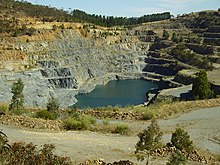A quarry is a type of open-pit mine from which rock or minerals are extracted. Quarries are generally used for extracting building materials, such as dimension stone, construction aggregate, riprap, sand, and gravel. They are often collocated with concrete and asphalt plants due to the requirement for large amounts of aggregate in those materials. The word quarry can include underground quarrying for stone, such as Bath stone.
Portland stone quarry on the Isle of Portland, England
Contents |
Problems
Quarries in level areas with shallow groundwater or which are located close to surface water often have engineering problems with drainage. Generally the water is removed by pumping while the quarry is operational, but for high inflows more complex approaches may be required. For example, the Coquina quarry is excavated to more than 60 feet (18 m) below sea level. To reduce surface leakage, a moat lined with clay was constructed around the entire quarry. Ground water entering the pit is pumped up into the moat. As a quarry becomes deeper water inflows generally increase and it also becomes more expensive to lift the water higher during removal – this can become the limiting factor in quarry depth. Some water-filled quarries are worked from beneath the water, by dredging.
Many people and municipalities consider quarries to be eyesores and require various abatement methods to address problems with noise, dust, and appearance. One of the more effective and famous examples of successful quarry restoration is Butchart Gardens in Victoria, BC, Canada.
Many quarries naturally fill with water after abandonment and become lakes. Others are made into landfills.
Quarry swimming
Water-filled quarries can be very deep with water, often 50 feet or more, that is often surprisingly cold. Unexpectedly cold water can cause a swimmer’s muscles to suddenly weaken; it can also cause shock and even hypothermia.[1] Though quarry water is often very clear, submerged quarry stones and abandoned equipment make diving into these quarries extremely dangerous. Several teenagers and young men and women drown in quarries each year.[2][3] However, many inactive quarries are converted into safe swimming sites.
Types of rock
An abandoned construction aggregate quarry near Adelaide, South Australia
An abandoned limestone quarry
Types of rock extracted from quarries include:
- Chalk
- China clay
- Cinder
- Clay
- Coal
- Construction aggregate (sand and gravel)
- Coquina
- Granite
- Gritstone
- Gypsum
- Limestone
- Marble
- Ores
- Phosphate rock
- Sandstone
- Slate
See also
- Clay pit
- Coal mining
- Collecting fossils
- Gravel pit
- List of minerals
- List of rock types
- List of stones
- Miner
- Mountaintop removal mining
- Quarries (biblical)
| Wikimedia Commons has media related to: Quarries |
References
External links
|
||||||||
|
||||||||||||||||||||
| This article about mining is a stub. You can help Wikipedia by expanding it. |
This information originally retrieved from http://en.wikipedia.org/wiki/Quarrying
on Monday 1st August 2011 2:24 pm EDT
Now edited and maintained by ManufacturingET.org




